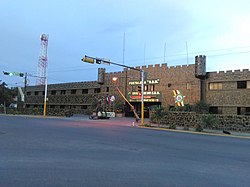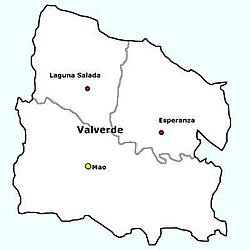Valverde Province
Valverde is a province of the Dominican Republic. It is in the northwestern part of the country. Its capital city is Mao.
 | |
 Location of the Valverde Province | |
| Coordinates: 19°37′37″N 71°02′16″W / 19.62694°N 71.03778°W | |
| Country | |
| Province since | 1959 |
| Capital | Santa Cruz de Mao |
| Government | |
| • Type | Subdivisions |
| • Body | 3 municipalities 10 municipal districts |
| • Congresspersons | 1 Senator 3 Deputies |
| Area | |
| • Total | 823.38 km2 (317.91 sq mi) |
| Population (2010)[1] | |
| • Total | 163,030 |
| • Density | 198.001/km2 (512.820/sq mi) |
| Time zone | UTC-4 (AST) |
| Area code | 1-809 1-829 1-849 |
| ISO 3166-2 | DO-27 |
| Postal Code | 61000 |
It was created on 1959. It was a municipality of the Santiago province before being elevated to the category of province.
Name
The province was named Valverde after José Desiderio Valverde, an officer of the Dominican army when the Dominican-Haitian War. Later, he was President of the Dominican Republic for one year (July 1857 - August 1858). He was from Santiago de los Caballeros.
History
Very few people lived in the lands of the Valverde province because it is very dry; there were only some people raising cattle in large ranches. The Spanish word for those ranches was Hato and there are many places in the province with the word "Hato" in their names (Hato del Yaque, Hato Nuevo, Hato Viejo, Hato del Medio) or "Hatico" (small "Hato").
The road from the border with Haiti to Santiago de los Caballeros, the second most important city of the country, went across this region and during the Dominican-Haitian War (1844-1856), Haitian armies came across this region and people did not want to live here.
In 1918, a Belgian engineer, Luis L. Bogaert ("Monsieur Bogaert"), built a canal to take water from the river to the fields and he began to grow rice. That was an important change in the province and now Valverde is a province where rice is an important product.
Since the Dominican Independence, the territory was part of the Santiago province. It was made a province in 1959 with lands of the Santiago and the Monte Cristi provinces, with the municipality of Esperanza; in 1978, Laguna Salada became a municipality of the province.[2]
The municipal districts of the province were created in:[2]
- 1998: Ámina
- 1999: Jaibónand Maizal
- 2000: Jicomé
- 2001: Pueblo Nuevo and La Caya
- 2002: Cruce de Guayacanes
- 2005: Boca de Mao
- 2006: Paradero
Location
The Valverde province is in the northwest part of the Cibao valley. It is bordered to the north by the Puerto Plata province, to the east and south by the Santiago province, to the southwest by the Santiago Rodríguez province and to the west by the Monte Cristi province.
Population
In 2010 (last national census), there were 163,030 people living in the Valverde province, and 129,071 (79.2%) living in towns and cities. The population density was 198.1 persons/km².[1]
Its population represents 1.73% of the total population of the country and the province is ranked as the 18th (out of 31 plus the National District) more populated province.
As of 2016[update], the total estimated propulation of the province is 171,754 inhabitants.[3]
The largest city of the province is Mao, its head municipality or capital, with an urban population (in 2010) of 49,714 inhabitants.[1]
Geography
The Valverde province has a total area of 822.9 km2 (317.7 sq mi).[1] It has 1.7% of the area of the Dominican Republic and it is ranked as the 28th (out of 31 plus the National District) largest province.
The altitude of the provincial capital, Mao, is 106 m (348 ft) above sea level.[4]
Most of the province is in a valley along the Yaque del Norte and Mao rivers.
The province is separated from the Puerto Plata province by the Cordillera Septentrional mountain range. The highest mountain of the province is in this range: "Loma Jicomé", also called "El Murazo"; it is 1,083 m (3,553 ft) high.[5]
South of the city of Mao are the Sierra Samba (a chain of low hills) and part of the Cordillera Central mountain range. The highest mountains of the island are in the Cordillera Central but in the Valverde province there are only low mountains.
There are several important rivers that flow through the territory of the province. The most important river is the Yaque del Norte, that flows from east to west; the other rivers are all tributaries of Yaque del Norte. Other important rivers are Mao and Ámina that come from the Cordillera Central; those rivers that flow from the Cordillera Septentrional are very short and do not have much water.
Climate
The climate of the province is a tropical climate, hot during the whole year.
Municipalities
There are 3 municipalities and 10 municipal districts (M.D.) in the province.[2]
| Municipality (code) |
Municipal Districts (code) | Population (2010) |
Area (km2) |
Density | Altitude (m) |
|---|---|---|---|---|---|
| Mao (270101) | 51,647 | 116.3 | 444.1 | 106 | |
| Ámina (270102) | 8,270 | 116.2 | 71.2 | 79 | |
| Jaibón (Pueblo Nuevo) (270103) | 8,309 | 73.2 | 113.5 | 88 | |
| Guatapanal (270104) | 8,637 | 109.5 | 78.9 | 156 | |
| Mao (270100) | 76,863 | 415.2 | 185.1 | ||
| Esperanza (270201) | 43,755 | 63.8 | 685.8 | 124 | |
| Maizal (270202) | 9,859 | 66.4 | 148.5 | 85 | |
| Jicomé (270203) | 3,047 | 33.3 | 91.5 | 223 | |
| Boca de Mao (270204) | 4,493 | 31.9 | 140.8 | 62 | |
| Paradero (270205) | 1,051 | 26.2 | 40.1 | 864 | |
| Esperanza (270200) | 62,205 | 221.7 | 280.6 | ||
| Laguna Salada (270301) | 10,425 | 41.9 | 248.8 | 63 | |
| Jaibón (270302) | 5,967 | 43.9 | 135.9 | 67 | |
| La Caya (270303) | 1,458 | 58.1 | 25.1 | 199 | |
| Cruce de Guayacanes (270304) | 6,112 | 42.2 | 144.8 | 83 | |
| Laguna Salada (270300) | 23,962 | 186.1 | 128.8 | ||
| Valverde (270000) | 163,030 | 822.9 | 198.1 | ||
Economy
The main economic activity of the province is farming and the main products are banana, plantain, rice and vegetables. Cattle is alto important in the province, mainly in the southern part of it.
Sugar cane was grown around the city Esperanza where there was a sugar factory. But the factory closed and sugar cane is not grown any more. Now there are some cloth factories in Esperanza.
Valverde Province Media
References
| Wikimedia Commons has media related to Lua error in Module:Commons_link at line 62: attempt to index field 'wikibase' (a nil value).. |
- ↑ 1.0 1.1 1.2 1.3 "IX Censo Nacional de Población y Vivienda 2010" (PDF) (in Spanish). Oficina Nacional de Estadística. June 2012. Retrieved 23 September 2013.
{{cite web}}: CS1 maint: unrecognized language (link) - ↑ 2.0 2.1 2.2 "División Territorial 2015" (in Spanish). Oficina Nacional de Estadística (ONE). October 2015. Archived from the original (PDF) on 14 November 2015. Retrieved 3 December 2016.
{{cite web}}: CS1 maint: unrecognized language (link) - ↑ "REPÚBLICA DOMINICANA: Población por año calendario, según sexo y grupos quinquenales de edad, 2015-2020" (in Spanish). Oficina Nacional de Estadística (ONE). Archived from the original (XLS) on 24 June 2016. Retrieved 3 December 2016.
{{cite web}}: CS1 maint: unrecognized language (link) - ↑ "Mao". Geonames.org. Retrieved 3 December 2016.
- ↑ De la Fuente, Santiago (1976). Geografía Dominicana. Santo Domingo, Dominican Republic: Editora Colegial Quisqueyana. pp. 90–92.


